Gualtiero Marchesi (Milan, 19th March 1930 - Milan, 26th December 2017), the Maestro of Italian cuisine died on the 26th of December at around 6 pm. He had been sick for some time. Identità Golose sends its condolences to his family
Gualtiero Marchesi was not suited for decadence. His figure was too prominent, his ego too strong, his role too important in the history of Italian cuisine for the Maestro – this is how he was called and he charmingly enjoyed being called – to peacefully accept that he was put aside, considered for his past but neglected for his present. So sometimes he exaggerated, he looked for visibility – following bad advice – that had nothing to do with his prestige. He sought attention and, not getting it, he got it, buy clumsily. The fault also goes to Italy, which did not cut him out a special role as the noble father of our fine dining – as perhaps it should have.
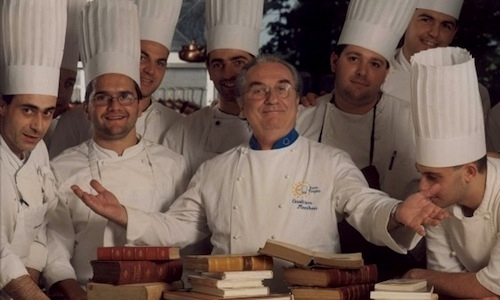
A famous photo of Gualtiero Marchesi. Andrea Berton, one of the many pupils who learnt the foundations of cuisine from the Maestro, is in the top right corner
Hence the self-feeding dynamic: the more he showed his aversion, almost a hostility against the new Italian cuisine (as with his embarrassing thrashing of
Massimo Bottura, «a friend of mine has just visited
Osteria Francescana. He showed me a series of dishes. I didn’t understand a thing. My cooks went there, and they didn’t like it», he said), the more he remained marginalised, increasing his irritation: «I now endure everything, I accept everything. Offering culture is pointless. You either have it, or you don’t».
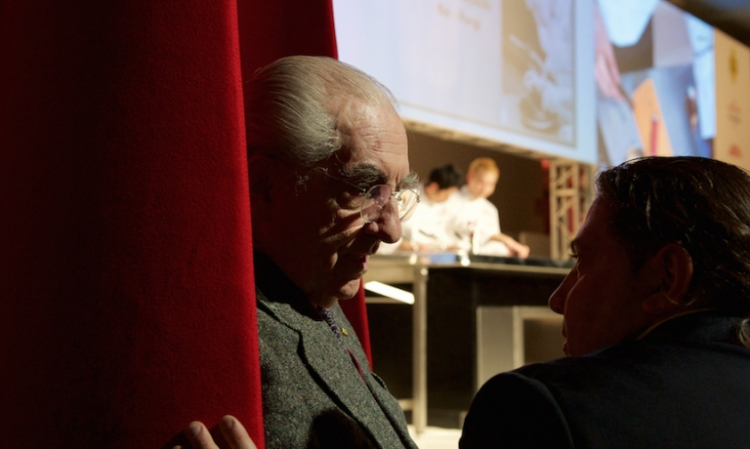
Gualtiero Marchesi speaks with Gianluca Fusto at Identità Milano 2015
A sad autumn that will not darken the memory of his greatness, thanks to two huge historic merits. Firstly, he has shaped the idea itself of Italian fine dining, freeing it from a sterile subjection to France, which in fact he loved: he never questioned its central role. For
Marchesi it was still a guiding light, but not a point of reference you had to follow blindly. He was the first to create an Italian model that could establish itself with its own means: they praised for this in France, and gave him the first three stars a restaurant in our country was to receive, in 1986. He said: «I believe my cuisine is Italian, and it’s new. It’s Italian because it does not deny our great regional gastronomic tradition in any way, but it’s also new because it keeps an alert eye on the transformed and changing conditions of life: tradition is therefore reinterpreted and experienced based on new needs and without presumptuous provincialism». One of his most important books,
La mia nuova grande cucina italiana, is from 1980.
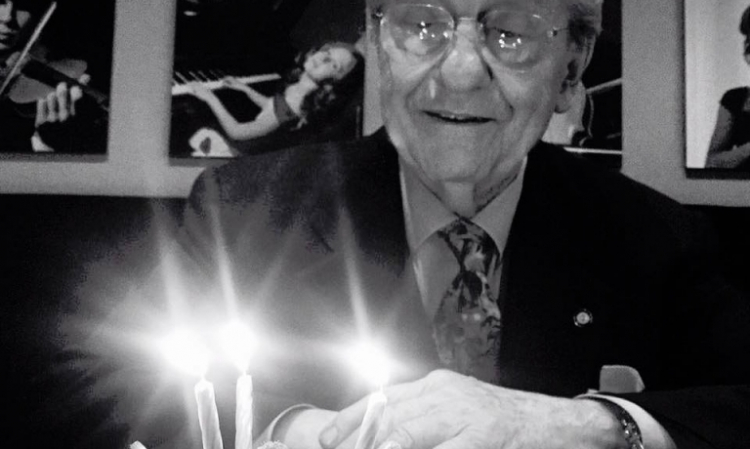
Marchesi on his 86th birthday in 2016
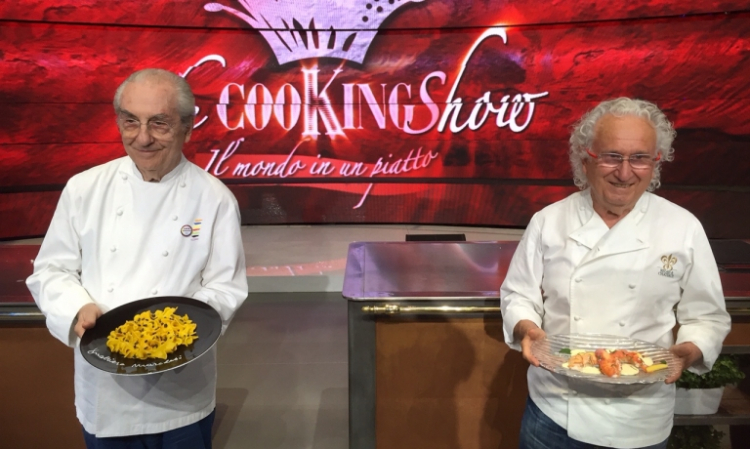
Gualtiero Marchesi and Ezio Santin: two friends and masters of Italian fine dining, respectively the first and the second chef to get three stars. This photo is from Identità Expo, where they participated in Rai’s The Cooking Show. See our Double interview with Marchesi-Santin
Secondly, the Maestro gave the right importance to the role of the cook. These are days of superstar chefs (“chef”: a word he loathed);
Marchesi has always criticised media over-exposure, even though he was an archetype of this. He was the one to set the path: cooks went from simple executors in the kitchen to
domini of taste, from the stoves to the covers of magazines. However, he thought to do so you needed something much different from the simple ability to present great food: you needed culture, elegance, research, «there’s too much seeking the extraordinary for the sake of it. Many chefs don’t know raw materials, they mistreat them. I call them “criminal culinary variety artists”. If they understood ingredients, they wouldn’t kill them». And again: «There are many cooks who are good, and many who are seemingly so. But I won’t name names. I’m only saying I like a cuisine that is based on memory, that is to say memorable dishes. Lately I find it hard to find».
He pointed out these ideas when on the 4th of October he resigned from the post of rector at
Alma, the school in Colorno that he contributed founding, in 2004: «The cuisine I’ve always aspired to is a cuisine of matter and shape, a cuisine as intense as culture and as a language that can express the best of us. You need more than how to master techniques, you need to be sensitive for beautiful things and curious about the world. (…) Recipes are like music scores and our category has two levels of preparation: good executors, and good composers. And you already know I always add a third level: artists. They are rare, but they can project cuisine on the level of other artistic languages. As it should be». He loved a quote from
Ermanno Olmi: «Cuisine is the greatest art of all, because it includes science». According to
Marchesi very few artists deserved glory and fame. He was among them, of course. He didn’t lack a very high (and deserved) opinion of himself.
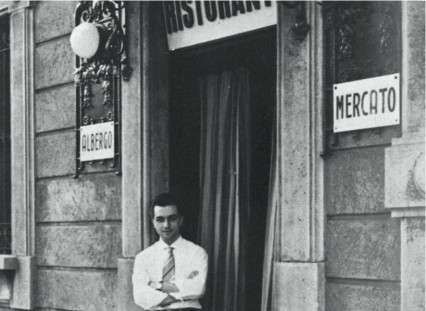
Young Marchesi in front of the entrance to the family restaurant, Al Mercato in Via Bezzecca, in Milan
He earned it. Born in Milan in 1930, his training began at
Kulm in St. Moritz and at catering school in Lucerne, Switzerland (1948-1950). Back in Italy, he worked in Milan at hotel
Al Mercato, owned by his parents (who were restaurateurs, originally from San Zenone al Po, Pavia), where he started to present avant-garde cuisine that drew from classic books: «One day, many years ago, I made a decision», he stopped playing [music ran in his blood, his Sicilian great-grandmother taught the
Florio family to play the piano. His wife was a performer, his daughters
Paola and
Simona, and grandchildren are musicians too] «because I had to create a new cuisine, unconceivable in our country; it was time to revolutionise courses, presentation, wine list. I wasn’t sure of what I could do, but I wanted to express myself. I did it well, based on Italian taste, but with elements that were new for our country: my cooking procedures were good, but many people thought my dishes were half raw».
When his parents left the restaurant they used to run in Via Bezzecca, in 1969, [where Mario Monicelli, Giovanni Testori, Gianni Agnelli, Luchino Visconti, Federico Fellini, Francesco Monzino used to go], «I wanted to travel around Italy: three months in every region to learn the various traditions and grow, improve myself. I didn’t do it. But I think it was good that I at least thought of it, I knew I had to work in this direction».
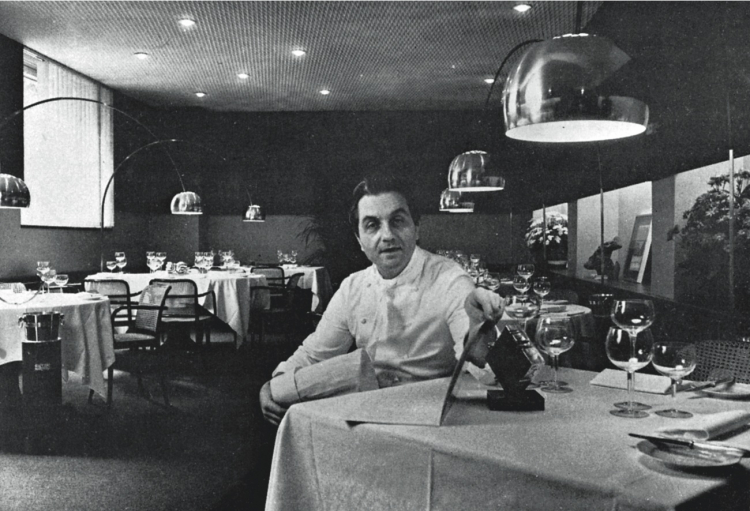
Gualtiero Marchesi in Via Bonvesin de la Riva in 1980
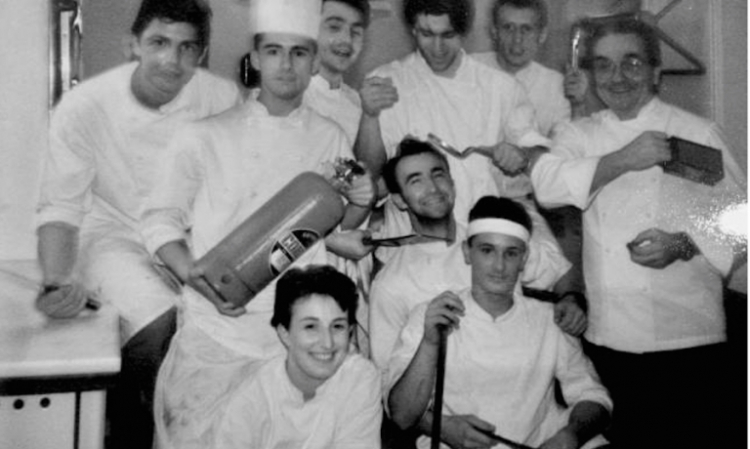
A historic brigade in Bonvesin de la Riva
Instead, he perfected his culinary techniques in some of the greatest French restaurants such as
Ledoyen in Paris,
Le Chapeau Rouge in Dijon, and the restaurant of the
Troisgros brothers in Roanne. He returned to Italy in 1977 and opened his restaurant
Gualtiero Marchesi di Via Bonvesin de la Riva in Milan. The success was immediate: a Michelin star right away, then two in 1979, and the highest acknowledgement in 1986, as mentioned. The restaurant became iconic: here he presented
nouvelle cuisine for the first time in Italy after learning it in France – he made seasonings and sauces lighter, dishes were served straight to the table from the kitchen, ingredients were based on market and seasonal offer - «however, I’d like to stress this, I then abandoned that trend after a year and a half in favour of my “total cuisine” because, among other things, I missed service in the dining room», which the French model was neglecting.
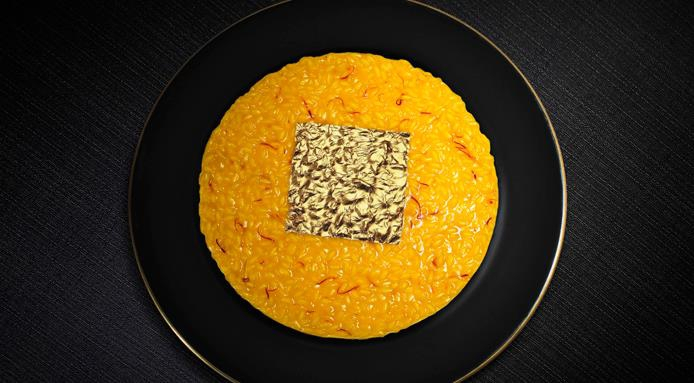
Risotto oro e zafferano. He upturned the rules of traditional risotto by placing a leaf of edible gold on top of it
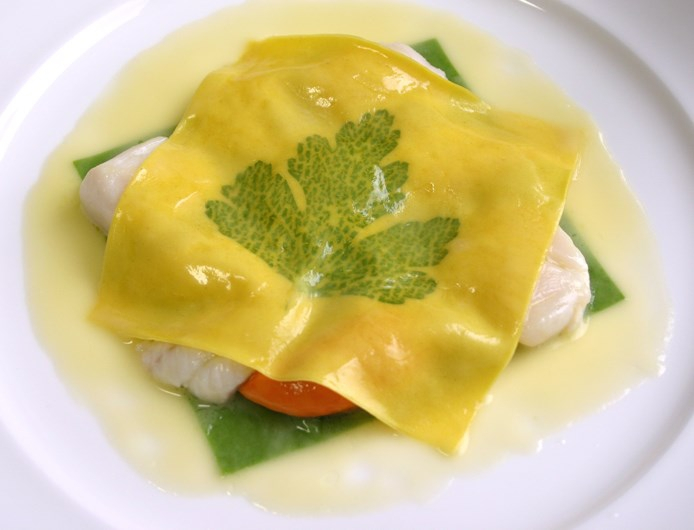
Raviolo aperto, «it’s basically a creative blasphemy because it’s like a single portion lasagna» (Paolo Marchi). “Raviolo aperto shows, above all, a changing of roles: a light veil of pasta, through which one can see a leaf of parsley, hides (and limits to a subordinate position) “noble” ingredients which should have had more importance given their culinary status... Pasta becomes the distinctive element: apart from the appearance, the most important fascinating element is this symbolic new arrangement, with a meaningful title which, in fact, only mentions the heterodox ravioli”. Gualtiero Marchesi, La cuisine italienne réinventée, Paris, Laffont, 1983
Here, and later, the Maestro created dishes that are now part of the history of Italian cuisine. Above all, his
Risotto oro e zafferano, from 1981, the
Raviolo Aperto, from 1982. And many more:
Dripping di pesce (2004), inspired by
Jackson Pollock,
Il Rosso e il Nero, the iconic
Seppia in Nero, Quattro Paste, Costoletta di vitello alla milanese, Terrina di fegatini di pollo, Pera cotta al vino rosso, crema inglese e croccanti di zucchero in due colori… And then many other creations that hint at the world of art: on top of the above mentioned
Dripping inspired by
Pollock and
Quattro Paste by
Andy Warhol, he also created references to
Alberto Burri (
Uovo al Burri),
Piero Manzoni (
Acrome di branzino),
Hsiao Chin (
Risotto mantecato al profumo di tartufi bianchi e… neri). He said: «I believe
Spaghetti al caviale, erba cipollina [from 1980 is my greatest masterpiece. Caviar is not the forte, there, spaghetti are! It took a while even for me to get it».
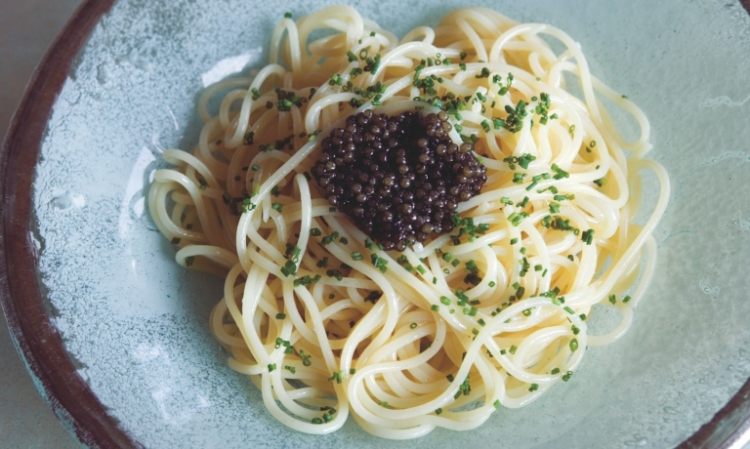
Insalata di spaghetti al caviale: «My greatest masterpiece»
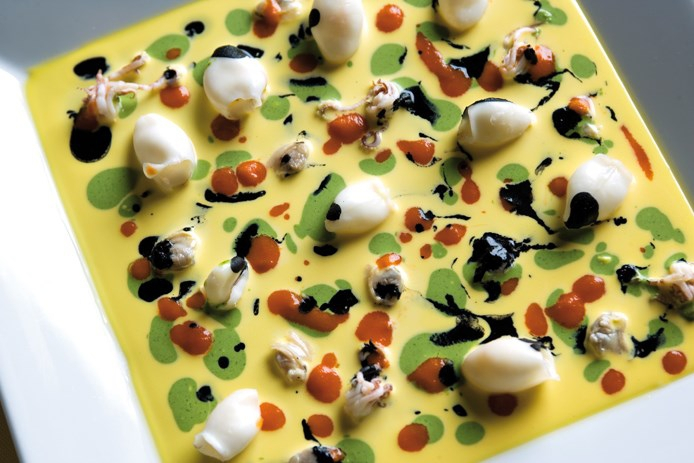
Dripping di pesce (2004): inspired by Jackson Pollock and his colour-dripping technique. The base is a light mayonnaise, enriched with white calamari and clams, the red is given by tomatoes. The black, instead, is squid ink mayonnaise and the green comes from parsley chlorophyll with mayonnaise. Photo by Borchi
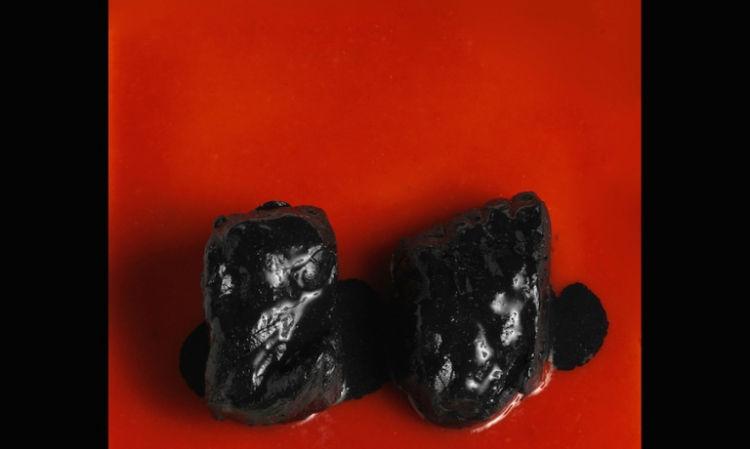
Il Rosso e il Nero, a monkfish dish inspired by the works of Lucio Fontana
His cuisine was not for all, of course, «I hate ignorant clients» he once said; he was inspired by a deep knowledge of ingredients and traditions, a necessary step to take before forgetting it all and acquire full creative freedom, while respecting seasonality. So his recipes were just guidelines, but the dishes themselves, as in a jam session, derived from the artist-chef’s capacity to improvise based on what was offered by the market: «The greatest flaw of Italian cuisine these days, is that it lacks research, product-knowledge.
Béla Bartók used to say that improvisation requires knowing matter: he was right. I love Japan, they give ingredients the right importance». He quoted
Toulouse-Lautrec: "In every art, and this applies to cooking too, great elegance is based on synthesis and simplicity; clearly you must base yourself on tradition, but then you have to forget it without deceiving it out of ignorance, negligence. This is how you become a cook without prejudgments, an anarchic who when making a dish only respects the rules of balance imposed by nature". And then, following
Mahler: «In recipes all is written except what’s essential».
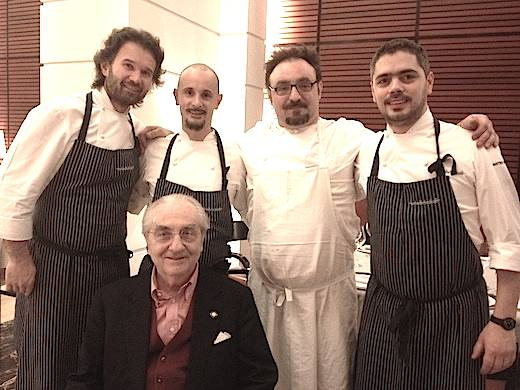
Dining with the Maestro. This is what happened during Identità Golose in Milan, in February 2013, when Carlo Cracco, to the left, invited two more pupils of Gualtiero Marchesi, Enrico Crippa and Paolo Lopriore. To the right, Matteo Baronetto who a few months later left Cracco’s restaurant to become chef at Cambio in Torino
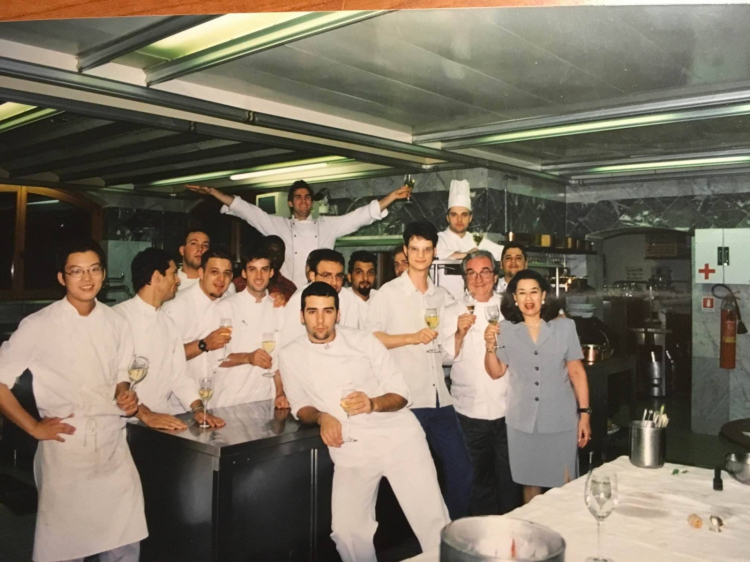
Marchesi with the brigade at Albereta, 1999
Bonvesin de la Riva (and then
Albereta, in Franciacorta, where he moved in 1993) was where a large part of the Italian contemporary restaurant scene trained: «many of the young men who worked in my kitchen are now cooks, who derserve this title, capable, each based on his attitude, to train more people, more enthusiasts».
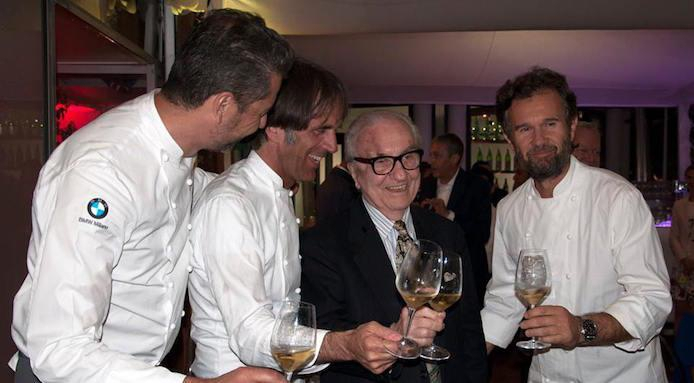
A recent photo of the Maestro with three of his Marchesi Boys: Berton, Oldani and Cracco
Like
Enrico Crippa,
Carlo Cracco,
Ernst Knam,
Alessandro Breda,
Andrea Berton,
Paola Budel,
Pietro Leemann,
Davide Oldani,
Paolo Lopriore, just to mention the most famous ones (see also:
Tutti gli allievi del Maestro). The latter has always been his favourite: «He’s an artist. At
Albereta I had
Crippa and
Lopriore together. One morning I see
Enrico packing: “I’m leaving, I’m fed up. I can stand him no more”. He was angry with
Paolo. Every night they decided which dishes they would make the following day, then
Paolo did the opposite, following his cook instinct…
Paolo is creativity. He’s genius». Then: «The two people with whom I worked best are
Paolo [
Lopriore] and
Daniel [
Canzian]: one said something, or added something, and then it was the other’s turn. A nice confrontation”.
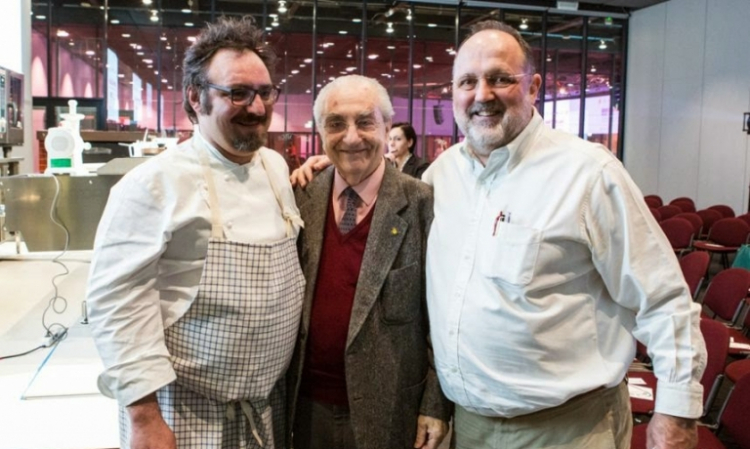
Paolo Lopriore, Gualtiero Marchesi and Paolo Marchi at Identità Milano 2015
In 1997
Albereta lost the third star. Ten years later the Maestro caused turmoil when he decided he no longer wanted to depend on scores, «I ask guides, if they want to, to publish their opinion; but I no longer want grades»; he was just back from Milan, where he opened
Il Marchesino, inside Teatro alla Scala. Many things had changed since his first adventure in Milan; he felt estranged from new trends, he started to criticise them («
Ferran Adrià? I liked the French much more:
Pierre and Jean Troisgros,
Alain Chapel… They were great. I believe the Catalan is instead a meteor. Chefs must be chemists with intuitions, not just chemists. You need scientific knowledge, but then you must cook. I like cuisine based on matter that takes into account other cultural influences»). He felt he was more and more estranged from his times: «I’m from 1930 and I believe I’ve been a man of avant-garde and revolution. Perhaps I no longer accept to be assessed based on current taste which, at this moment, no longer belongs to me».
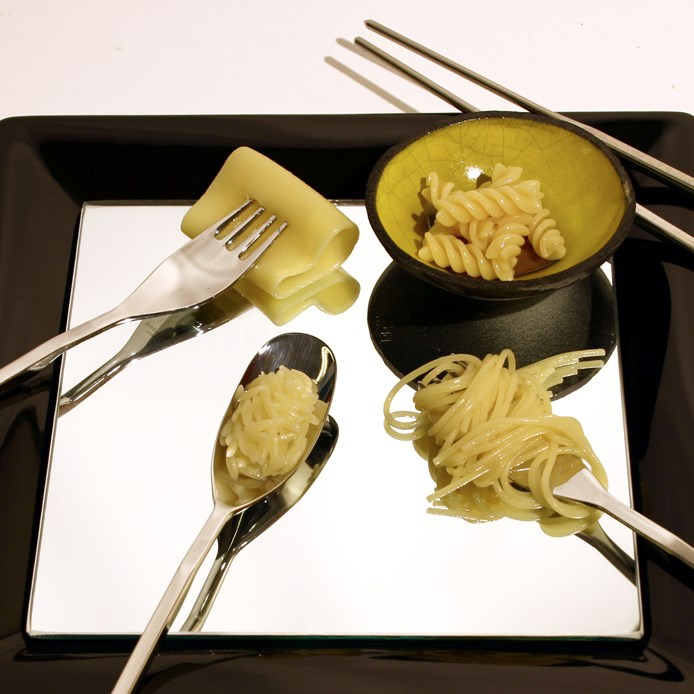
Quattro Paste: was created by Marchesi in 2000, after a show by Andy Warhol and seeing his famous serigraphy in four parts of Marylin Monroe. It was his reflection on pasta, its shape and texture, so as to best enjoy wheat
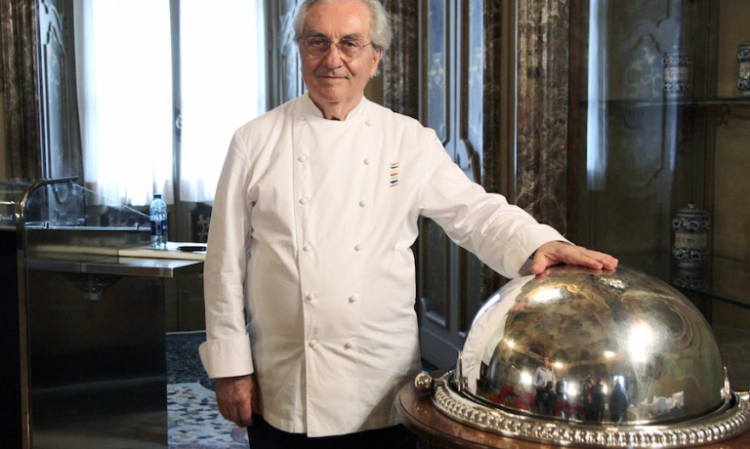
Gualtiero Marchesi portrayed at Marchesino in Piazza della Scala in Milan
It was a said autumn, as we said. In June, this summer, his wife
Antonietta Cassisa, died and now rests in San Zenone’s cemetery, where the
Marchesi family owns a family chapel. He was already sick and reduced his public appearances. On his last visit, he told the students at
Alma: «The time has come for me to focus on something I hold very dear. A project I’ve been working on for some time, and which will soon be ready. Following the example of the [retirement home for musicians]
Casa di riposo dei musicisti, I’d like a
Casa di riposo dei cuochi [for cooks]», in Varese. He didn’t get the chance to live there.
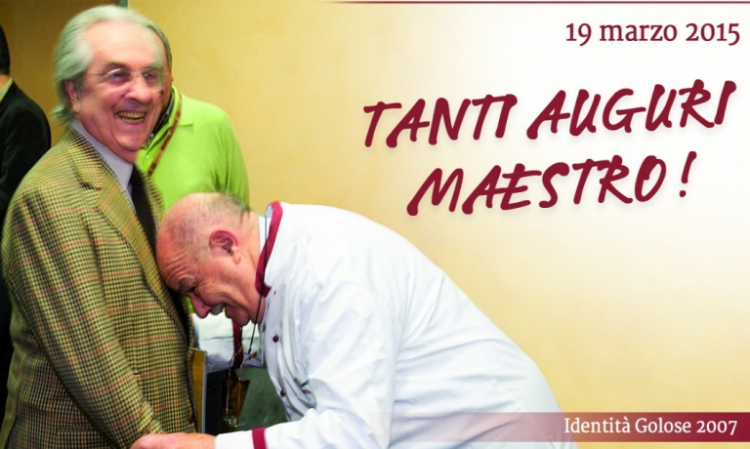
Identità Milano 2007: Gualtiero Marchesi receives a tribute from Pierre Troisgros, an untouchable giant of French cuisine. Identità Golose found this photo to celebrate the Maestro’s 85th birthday, in 2015
When he turned 85, (see:
Marchesi’s 85 candles. And the "chef’s rules" he wrote on that occasion, see:
Creating is not copying) we asked him to sum up his life. He said: «I was a bit naughty, I always thought that any chance you don’t take is lost forever... Oh, come on, I think I did well». We owe him a lot. (
Translated into English by Slawka G. Scarso)
«People sometimes say my name is mentioned as a possible senator for life. I would like it, and you know why? Not for me, I promise: but it would be an important proof of attention for Italian cuisine» (Gualtiero Marchesi)